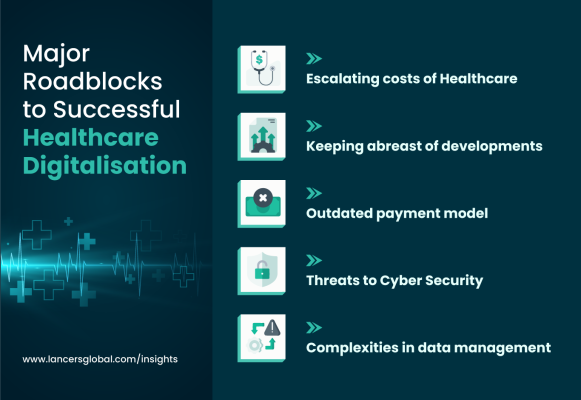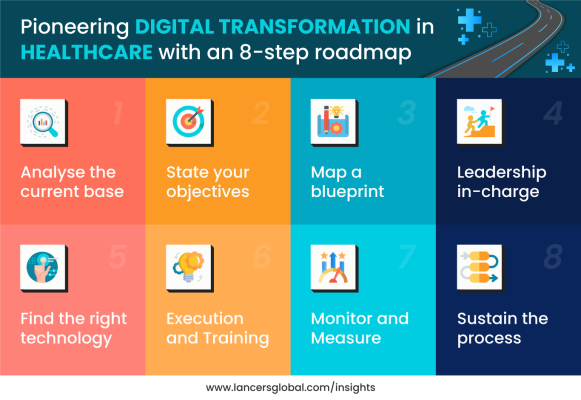Redefining the Future of Healthcare with Digital Transformation
Digital transformation, which was once a buzzword, has now become a necessity. A dynamic transition is rapidly approaching where new technologies are on the verge of having an immense effect in every area, and healthcare is not exempt from this. Over the past two decades, the digital transformation in healthcare industry has undergone significant changes that have improved the accessibility, quality, and cost of care as well as discovered the solutions for existing issues while solving the new ones at the forefront.
In Spite of the advantages that technology can bring in this sphere, there are some roadblocks that are stopping the industry leaders from implementing digital transformation in the Healthcare sector. In a recent survey, it was found that - healthcare and pharmaceutical companies have been less likely to adopt digital transformation, with only 7% adopting them, which is less than half when compared to 15% of companies in other industries.
Following this survey, there are some major questions that arise for the healthcare sector:
- How do we provide healthcare services to everyone, including the socially and economically disadvantaged as well as the systematically marginalised?
- How do we ensure healthcare access in remote regions?
- How can we make healthcare more sustainable and approachable?
Digital transformation in healthcare is a fundamental pillar of a patient-first approach to healthcare. It has pioneered the road for quicker delivery, offering effective treatment and providing the patients continuous access to their medical information. By embracing and employing up-to-date tools, techniques, and procedures, digital transformation in healthcare will lead to enhancing the customer experience, facile operations and eliminating the redundant processes involved in the system and organisation at large.
How can Digital Transformation Enable Healthcare as an industry?
The digital transformation has the potential to revolutionise healthcare with its extensive benefits. AI-powered tools can analyse huge amounts of medical data, identifying patterns and trends that would be impossible for humans to detect. Its major purpose is to upgrade and modernise outdated methods and systems using the latest technologies. But if you’re still not convinced, let’s check out the benefits of digital transformation in healthcare for patients, and the healthcare industry as a whole.
Upside of implying Digital Transformation in Healthcare for Patients
1. Improved Access and Personalisation: Digital healthcare provides patients with prompt and personalised access to healthcare services, allowing for accurate health diagnoses anytime, anywhere.
2. Streamlined Health Data Management: Centralising healthcare data makes it convenient for patients to access and manage their health records across multiple devices and platforms.
3. Easy Appointment Scheduling: Patients can easily schedule appointments with healthcare providers at their convenience using digital healthcare tools, which save them time and make consulting more convenient for them.
4. Enhanced Doctor-Patient Communication: Digital healthcare offers a variety of communication channels, including video calling, email, and chat, allowing patients to receive consultations, treatment strategies, and drug prescriptions.
5. Real-Time Health Metric Tracking: Patients can monitor their health metrics, such as heart rate, body temperature, blood volume pulse, and sleep patterns, in real-time, enabling them to monitor their health status frequently.
6. Improved Patient Experience and Outcomes: Digital transformation enables healthcare providers to offer accurate diagnoses and personalised treatment plans based on data insights, resulting in better patient outcomes and quality of life.
Upside of Digital Transformation in Healthcare for Professionals and Organisations
1. Streamlined Workflows: Digital healthcare replaces paperwork with digital records, resulting in simplified processes, reduced manual labour, improved deliverability, and the ability to focus more on patient care.
2. Improved Business Continuity: Digital healthcare portals make it easier for healthcare professionals to offer remote care and for patients to receive on-demand support, ensuring long-term patient continuity and more business.
3. Centralised and Secure Database: Digitalization creates a secure database by encrypting patients’ data, which can help the healthcare system in categorising, storing, and analysing it on a central platform, with role-based access to authorised personnel, leading to better decision-making and improved patient care.
4. Reduced Operational Costs and Improved ROI: Digital Transformation can help in the automation of repetitive tasks, manual processes, administrative tasks, and paper-based systems, which can help reduce operational costs, resulting in more cost-effective services and a higher ROI.
5. Advancing Medical Research and Development: By collecting and analysing data from various sources, healthcare organisations can discover hidden disorders and their medical solutions, thus fueling medical research and development.
6. Better collaboration and communication: Digital technologies can facilitate communication and collaboration among healthcare providers, leading to more coordinated and comprehensive care.
Major Roadblocks to Successful Healthcare Digitisation
The healthcare sector faces various threats ranging from demographic changes, regulatory pressures, technological advancements, financial constraints, and many others that make it difficult to provide quality care to patients. Addressing these challenges will require a collaborative effort from various stakeholders, including governments, healthcare providers, insurers, patients, and technology companies. Let's check out the major challenges in healthcare and their anticipated solutions:

1. Escalating costs of Healthcare
The rising cost in healthcare is arguably the biggest challenge facing the industry today. The cost of health care changes people’s behaviours, like forgoing seeing a doctor when they feel sick or avoiding preventive health visits entirely. It is driven by several factors, including the ageing population, chronic diseases, advances in medical technology, and administrative costs. The high cost of healthcare results in financial burdens on individuals and families, leading to reduced access to care and increased rates of medical debt. Additionally, it can strain the healthcare system, leading to lower quality care and reduced access to healthcare for those who need it most.
Solution - Value-based care models that focus on improving patient outcomes rather than volume of services can reduce costs, reduce unnecessary testing and treatments, and improve the quality of care. By addressing these issues, we can create a sustainable healthcare system that provides access to high-quality care while reducing financial burdens on individuals and families.
2. Keeping abreast of developments in medical science
Keeping up with advances in medical science is a crucial problem in the field of healthcare. As medical science continues to advance at an unprecedented rate, it becomes increasingly difficult for healthcare professionals to stay updated with the latest developments. This is particularly true for doctors, nurses, and other healthcare workers who have already completed their formal education and training.
In order to provide the best possible care to patients, healthcare professionals must be able to stay informed about new treatments, technologies, and procedures that can improve patient outcomes. Failure to do so can lead to suboptimal care, missed opportunities for early intervention, and delayed diagnosis.
Solution - The pace of change in medical science means that healthcare professionals need to be constantly engaged in lifelong learning to stay relevant and effective in their roles. Organise training programmes to educate your staff and patients on the use of new software and explain its importance to them while giving them proper time and space to learn and adopt new methods.
3. Outdated payment model
The healthcare industry is constantly evolving, and one of the persistent challenges faced by the sector is the development of an effective payment model. Healthcare providers are looking for sustainable payment models that would support their operations, ensure patient satisfaction, and improve the quality of care provided.
However, developing an effective payment model is a complex task, and there is no single solution that can meet the diverse needs of the healthcare system. Also, implementing such models requires significant investments in technology and infrastructure, and it can be challenging to develop appropriate metrics for measuring patient outcomes. The current fee-for-service model, which reimburses healthcare providers for each service provided, has been criticised for promoting unnecessary medical procedures and increasing healthcare costs.
Solution - The shift towards value-based care, which rewards healthcare providers for improving patient outcomes and reducing costs, is gaining traction. The healthcare industry must continue to explore innovative payment models that align with the needs of patients, healthcare providers, and payers.
4. Threats to Cyber Security
The role of cybersecurity in healthcare has become increasingly critical in recent years due to the rise of cyber threats and attacks. Patient data and medical records contain sensitive information, and healthcare organisations must ensure that they are protected against unauthorised access and breaches.
Cybersecurity threats in healthcare can include ransomware attacks, phishing scams, and other forms of malware that can compromise the confidentiality, integrity, and availability of patient data. By addressing these challenges and establishing robust cybersecurity measures and protocols, organisations are essential for digital transformation in healthcare.
Solution - Healthcare providers must ensure that their staff is trained in cybersecurity best practices, including strong password management, establishing incident response plans, identifying phishing emails, and maintaining secure remote access to patient data. Staying in line with all relevant regulatory standards, such as HIPAA, the use of firewalls, intrusion detection and prevention systems, and regular security audits to identify and address vulnerabilities.
5. Complexities in data management
In recent years, the healthcare industry has been transformed by the advent of big data analytics. The healthcare sector is generating vast amounts of data, including electronic health records (EHRs), clinical trial data, insurance claims data, and patient-generated data from wearables and other monitoring devices.
The challenge lies in the ability to manage and analyse this massive volume of data effectively. One of the primary issues facing healthcare organisations is the integration of data from multiple sources and the need to ensure data quality, privacy, and security. Moreover, there is a lack of standardisation in data collection and sharing, which can lead to data silos and hinder data analysis efforts.
Solution - Healthcare providers can use big data analytics to identify patterns, trends, and anomalies in patient data to improve diagnosis, treatment, and outcomes. The use of big data in healthcare analytics can also help reduce costs by optimising resource utilisation and improving operational efficiency. It has the potential to transform the healthcare industry by enabling personalised medicine, predictive analytics, and more efficient clinical workflows.
Pioneering Digital Transformation in Healthcare with an 8-step roadmap
Starting the digital transformation of healthcare requires careful planning and execution. In this section, we will dive deep into the changing healthcare ecosystem and how to avail ourselves of the benefits of digital transformation in healthcare in an actionable way. Let us explain the process of building a roadmap for digital healthcare and sustaining it in the long run:

1. Begin by analysing the current foundation: It is important to identify what technologies are currently being used and what gaps exist in terms of technology. This must include the existing legacy system, patent engagement software, real-time location system, EHR, telemetry, etc. Once you have the information, look into what is working for you and what could be improved.
2. State your objectives and goals: Clearly define what you want to achieve with digital transformation. This can include improving patient care, enhancing operational efficiency, reducing costs, or all of the above. Once you have all the information, involve the operations team in prioritising each department’s wish lists within the budget. Next, think about the metrics: ROI, patient safety, and staff safety satisfaction. Lastly, determine how to use technologies for achieving those key performance indicators.
3. Map a blueprint for the implementation: Develop a plan that outlines the steps needed to achieve your objectives. This should include timelines, milestones, and metrics to measure progress. Start by working on the design of the process and tech mapping to determine what can be solved with a process, and what needs to be incorporated into a technology. Then, move forward with an integrated delivery method where you clarify the important questions like who would own the project and who would take responsibility for the integration.
4. Leadership should take charge: To ensure the success of digital transformation, it is essential to secure buy-in from leadership and other stakeholders. It is important to be associated with leadership that is conscious of all the little details, keeps projects on track, moves towards the fulfilment of a vision, and ensures that the KPIs are met.
5. Find the right technology: Healthcare organisations must choose the right technology solutions to support their digital transformation strategy. This may include electronic health records, telemedicine solutions, wearable devices, big data analytics, artificial intelligence, and other emerging technologies. Before rolling out any new technology solutions, healthcare organisations should conduct pilot tests to ensure that the solutions are effective and can be scaled across the organisation.
6. Execution and Training: Once the technology solutions have been selected, healthcare organisations should provide training and education to staff to ensure they are proficient in using the new technology and implementing the solutions effectively. This may involve providing staff with training on how to use electronic health records, telemedicine solutions, or other technology solutions.
7. Monitor and Measure: After implementation, healthcare organisations should monitor the performance of the technology solutions and evaluate their effectiveness. This may involve collecting data on patient outcomes, staff productivity, and other metrics to determine if the technology solutions are meeting your objectives and providing the desired results.
8. Sustain the process: The final step in the digital transformation process is continuous improvement. Healthcare organisations should continue to assess their technology solutions, make adjustments as needed, and identify opportunities for further improvement.
Conclusion
The implementation of digital transformation in the healthcare sector is a complex process. Nevertheless, the advantages of digital transformation in healthcare are unquestionable. Even though there are no easy solutions, it is essential to keep working on healthcare challenges that require cohesive solutions to enhance the system while addressing the challenges faced by all the stakeholders.
Global Lancers, which has extensive experience in providing top-notch digital transformation services, provides tailor-made digital transformation solutions to meet the specific needs and objectives of any healthcare institution. We are available to assist you in bringing your novel healthcare project to fruition by embracing new technologies and collaborating to overcome associated risks and create a healthcare system that is more patient-focused, efficient, and effective than ever.
As we advance, we can anticipate even more progress in digital healthcare solutions, driving the industry's growth and development. Embrace the possibilities that technology presents and strive for a healthier future.
Recent Posts








Add Comment
0 Comments